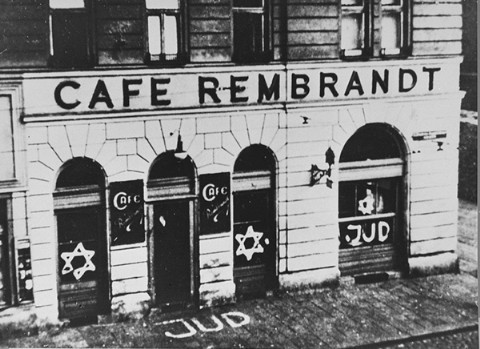
Vienna
Background
Vienna was the capital of a large multi-national empire under the German-speaking Habsburg dynasty for five centuries. After 1918, following World War I, Vienna became the capital of the small Republic of Austria. Vienna's population of 1.9 million was 28 percent of the country's entire population in 1934. In 1938, some 170,000 Jews lived in the city, as well as approximately 80,000 persons of mixed Jewish-Christian background. Including converts from Judaism, the Viennese Jewish population may have been as high as 200,000, more than 10 percent of the city's inhabitants.
Vienna was an important center of Jewish culture and education. The city was also a center of Zionist thought and Theodor Herzl, the father of Zionism, had studied at the University of Vienna. Many Viennese Jews were well-integrated into urban society and culture. Jews made up significant percentages of the city's doctors and lawyers, businessmen and bankers, artists and journalists.
In March 1938, Nazi Germany incorporated the Austrian Republic in what became known as the Anschluss. Once in power, the Nazis quickly applied German anti-Jewish legislation to Vienna and the Austrian hinterland. The intent of this legislation was to exclude Jews from the economic, cultural, and social life of the former Austria. Officials closed Jewish community offices and sent the board members to the Dachau concentration camp. By the summer of 1939, hundreds of Jewish-owned factories and thousands of businesses had been closed or confiscated by the government.
Emigration from Vienna
After the Anschluss, Vienna became the focal point of Jewish emigration from Austria. Those seeking exit visas and other documentation necessary for emigration were required to stand in long lines, night and day, in front of municipal, police, and passport offices. Would-be emigrants were forced to pay an exit fee and to register all of their immovable and most of their movable property, which was confiscated concurrent with their departure from the country.
In 1938, SS Captain Adolf Eichmann (later the Reich's most zealous deportation "expert"), working closely with the Inspector of Security Police and SD in Vienna, Brigadier General Walter Stahlecker (later commander of a mobile killing unit, Einsatzgruppe A), established a Central Office for Jewish Emigration in Vienna. By May 17, 1939, nearly half of Austria's entire Jewish population had emigrated, leaving only approximately 121,000 Jews in Austria (all but 8,000 in Vienna). Though the pace of emigration slowed to a trickle with the increasing threat of war and its outbreak in September 1939, another 28,000 Jews were able to leave Austria between May 1939 and the middle of 1942.
Kristallnacht in Vienna
The pogrom of November 1938, popularly known as Kristallnacht (or "Night of Broken Glass"), was particularly brutal in Vienna. Members of the Nazi Party and its various paramilitary organizations (including the SA and the SS) were joined by civilians, emboldened by the lack of police interventions, to form "spontaneous" mobs that torched most of the city's synagogues and small prayerhouses. Many of these burned to shells as the public and fire department personnel looked on, intervening only when the blaze threatened neighboring buildings. Jewish businesses were also vandalized and ransacked.
German police officials arrested some 6,000 Austrian Jews and deported them to the Dachau concentration camp. A small number of those arrested were sent to Buchenwald concentration camp. Only those who promised to emigrate immediately, leaving their property behind, were released. Twenty-seven Austrian Jews were murdered in the course of the pogrom.
Deportations from Vienna
During the war, German policy regarding the Jewish population shifted from one of expropriation and Jewish emigration to forced deportation. Systematic mass deportations of the Viennese Jewish population began in the autumn of 1939 when, on Eichmann's orders, SS and police officials deported some 1,500 Jews from Vienna to a detention camp in Nisko, Poland. In late winter 1941, the Germans deported approximately 4,500 additional Viennese Jews to occupied Poland (primarily to Izbica and other ghettos in the Lublin region), where most were later murdered. In the autumn of 1941 and the spring of 1942, the Germans deported thousands more Jews from Vienna to cities in the occupied Soviet Union (Riga, Kovno, Vilna, and Minsk). Locally stationed SS and police officials then murdered these Jews, mostly in mass shootings. Thousands of Viennese Jews were also deported to the Lodz and Theresienstadt ghettos.
By October 1942 only about 8,000 Jews remained on Austrian soil. German officials deported approximately 1,900 of these Jews in 1943 and 1944. Some Jews remained in hiding. Many of the others still in Vienna were persons married to non-Jews. All in all, SS and police deported some 47,555 Austrian Jews to the east. The vast majority of these Jews, along with approximately 18,000 refugees to Austria, were murdered during the Holocaust.
Forced Labor in Vienna
In 1944, German SS and police officials, assisted by Hungarian gendarmes, deported tens of thousands of Hungarian Jews to Austria to perform forced labor. Thousands of Hungarian Jews were incarcerated in Vienna's Strasshof labor camp, where they were deployed building fortifications. Several of the forced-labor camps in Vienna were under the administration of the Mauthausen concentration camp.
The End of the War
After waging a battle for the city, the Soviet Red Army took control of Vienna in April 1945. That month, the Soviets allowed a new Austrian government to form and appointed a new mayor of Vienna. In July 1945, the Allied powers agreed that an Allied Commission for Austria with representatives from the United States, Great Britain, France, and the Soviet Union would control the county. The city of Vienna was divided into five occupation zones—one zone for each of the Allied powers and one international zone in the city center. Austria remained officially under four power occupation until 1955.
Critical Thinking Questions
- Learn about the lives of the Jews in the community of Vienna before 1938.
- What pressures and motivations might have influenced non-Jewish people in Vienna to assist in the persecution of Jews, stand aside, or resist?